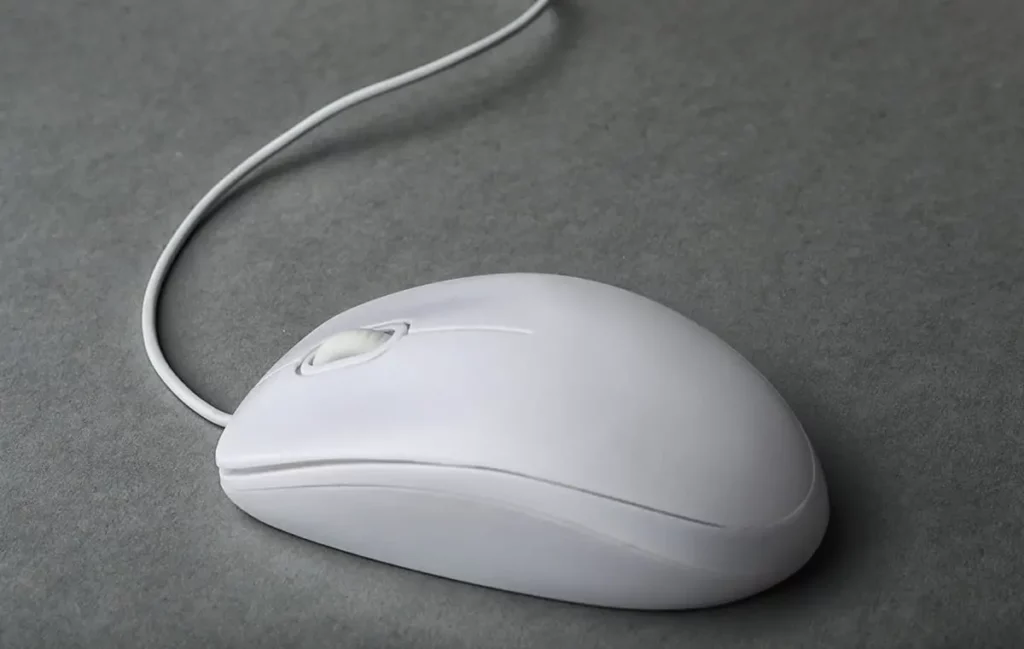The mouse is one of the essential parts of a computer, and when it starts squeaking, it can be very irritating. So, how do you stop a mouse wheel from squeaking?
Here’s a DIY guide on how to stop a mouse wheel from squeaking:
- Detach the mouse from the computer.
- Open the mouse.
- Remove the mouse wheel.
- Find and fix what’s causing the wheel to squeak.
In this article, we discuss more details on what to do to stop a mouse from squeaking. We also discuss how squeaking happens, other mouse problems, how to fix them, among other subtopics.
1. Detach the Mouse From the Computer
Start by disconnecting the mouse from the computer. If it’s battery powered, remove the batteries. Detaching the mouse from the computer prevents shock in case you accidentally touch a live electrical component.

Disconnecting the mouse from the computer also prevents shorting should the mouse come into contact with water or any other liquid. Simply put, never work on any electronic device while it’s still connected to a power source.
2. Open the Mouse
It’s not hard to open a mouse. Follow these steps:
- Flip the mouse over.
- Use an awl to remove the rubber pads covering the screws on its base.
- Use a Phillips head screwdriver to unscrew it.
- Place the screws somewhere safe, preferably a small container, to avoid misplacing.
- Pry apart and also separate the mouse’s top cover from the base using the awl:
- Start from the top side, where the mouse’s cable gets into its interior.
- Separate the bottom and top parts carefully to avoid breaking or snapping the plastic tabs that hold the top and bottom parts together.
Take note that this task requires a rather small screwdriver, like the Klein Tools 32614 Pocket Screwdriver Set (available on Amazon.com). It’s one of the best since it features concealable tips and has a pocket clip making it easy to carry in your pocket.
Also, don’t skip out on getting a small container to hold the screws while you work on the mouse, since they can easily roll when placed on a flat surface. If you lose the screws, you’ll have no option but to get others.
3. Remove the Mouse Wheel
The mouse interior isn’t very complex, so it should be easy to locate. In general, you must pull it open and remove the PCB board from the plastic tray by holding it by its side and pulling it from the back. Make sure no spring gets lost as you remove the board.

But note that how you remove the mouse wheel can depend on whether it’s an optical mouse, a non-optical mouse, or a Dell mouse.
Optical mouses are very durable. However, if you have an optical mouse that you’ve been using for several years, the chances are higher that it has accumulated dust, which often causes squeaking.
Optical mouses have metal arms wrapped around their post. When opening it, use a screwdriver to pull the post from the arms, then remove the metal that connects the grooves in the wheel. You’ll then need to remove the plastic wheel and get another one.
A non-optical mouse has spokes on the scroll wheel’s side. These spokes are responsible for the clicking of the mouse. When opening this mouse, take the little spring hitting the spoke while rotating the wheel.
Dell mouses have two springs. One spring is in the plastic piece where the mouse wheel rotates. The other spring is close to the post in the center of the mouse wheel.
4. Find and Fix What’s Causing the Wheel To Squeak
The two main causes for a squeaking mouse wheel are accumulated dirt and friction.
Accumulated Dirt
If the wheel has some dirt, clean it following these directions:
- Flip the mouse over and gently pull back to remove its top panel. This will expose the mouse wheel.
- Spray the wheel using an air-spray can until it’s completely free of dust.
- Using a cotton swab with isopropyl alcohol, wipe the circumference of the wheel. Give it time to dry completely before assembling it. Solimo Isopropyl Alcohol on Amazon.com is great isopropyl alcohol because it evaporates very fast, leaving a dirt-free spot. Its solvency is also very powerful.
- Use cleaning wipes to clean the entire surface of the mouse. This is just to get rid of the dust that might have accumulated on the surface. If there are tough stains, dampen a cloth with alcohol, then wipe the stains. Remember, the cloth should only be damp and not dripping. A dripping cloth might deposit liquids in the internal components of a mouse, causing damage.
- Reassemble and check if the wheel has stopped squeaking. If it hasn’t, there might be another problem.
Friction
Too much friction in the wheel can make it squeak. If the wheel’s oil doesn’t have oil, it might start squeaking due to dryness. Oiling a mouse will solve this problem.
You only have to open up the mouse, then lubricate the wheel using WD-40 oil. The WD-40 – 490224 Multi-Use Oil (available on Amazon.com) is one of the best. Only put a small amount of the oil to prevent it from dripping into the other parts.
While you have your mouse opened, it’s a good idea to remove dust from other parts apart from the wheel to prevent future problems. Use a toothpick to remove any particle from the crevices in the inner parts of the mouse.
What Causes a Mouse Wheel To Squeak?
A mouse wheel is caused to squeak by dirt or fluff getting accumulated in the wheel scroll. The slots get blocked, which interrupts the infrared beam preventing the signal from forming a nice waveform. The dirt particles can also create a friction that makes the slot squeak.
Understanding exactly how squeaking happens comes with comprehension of how a mouse wheel works. The scroll wheel is simply a wheel-like device with slots and spokes. Usually, the spokes are thicker than the slots.
There’s also an infrared LED that shines a beam through the scroll wheel. This sensor then picks the beam on the other side of the wheel. The spokes break this beam repeatedly as the wheel turns.
This makes the output signal produced by the phototransistor move in a pulse using a waveform. The output signal is then processed by an IC (integrated circuit) then sent to the computer. The pulses frequency increases as you roll the wheel faster.
Does Water Cause a Mouse Wheel To Squeak?
If your mouse came into contact with water, you might be wondering whether that’s the cause of the squeaking.
Water does not make a mouse wheel squeak. However, a spill can damage the internal components, some of which are irreparable. If your mouse gets wet, try and dry it as fast as you can. Disconnect the mouse from the computer, then wipe it using a dry cloth.
Do that as fast as you can to prevent the water from getting inside.
Open the mouse, then place it in front of a fan. If you notice any green or blue powder forming, that’s an indication the mouse has already started corroding. Reassemble it and connect it back to the computer to check whether it’s functioning or not.
If the mouse has corroded quite significantly, it can fail to work, and the best option here is to replace it.
Tips To Prevent a Mouse From Squeaking
To prevent your mouse from squeaking in the future, here are a few simple tips to follow:
- Wipe the mouse frequently to get rid of dust
- Ensure the surface on which the mouse rests is free of dust and other particles
- Clean your hands before using the mouse
- Avoid taking foodstuffs near the mouse to prevent particles from getting in
What To Do if a Mouse Wheel Still Squeaks After Being Cleaned
Sadly, if your mouse does not stop squeaking even after all attempts discussed above, it might be time to get another one. But this is nothing to fret about, as mouses are inexpensive and readily available in stores and online.
However, if the squeaking was accompanied by other problems, such as not scrolling properly, you might need to adjust the wheel settings of the computer or update the drivers.
How To Fix a Mouse That’s Squeaking AND Not Scrolling
If a mouse is squeaking, there’s a very high possibility that it’s also not scrolling – or at least not properly.

Indeed, dirt can also interfere with the scrolling of a mouse, but other issues could cause the problem too. If you tried removing the dirt or lubricating it using WD-40 and the mouse is still not scrolling as intended, consider the following:
Replace Its Batteries
Low battery power in wireless mouses is usually responsible for various problems, such as the mouse not scrolling. Changing the batteries will solve the problem immediately if the power is the problem. If the batteries are rechargeable, charging them will fix the problem too.
Old batteries may also leak acid and corrode the inner part of the mouse, which might lead to irreversible damage.
Check the Wheel Settings
If your computer is running on Microsoft Windows, wheel settings might be the cause of the problem. Check the settings option and check whether there have been changes that could interfere with the mouse’s normal function.
When using a mac, check the scrolling direction to see whether it’s what you prefer.
Update the Drivers
Windows have drivers for various peripheral devices, including the mouse. If your mouse isn’t working properly, you might have to update its drivers manually.
To do this, go to the website of its manufacturer. Check on either the download or support pages of the website to locate the updated drivers, and follow these steps:
- Select the mouse’s model, then proceed to the operating system.
- Download the file displayed and agree to the terms, if necessary.
- If the file is zipped, unzip it by using a compression utility; If the file is executable, double-click it for the compressed file to be automatically extracted.
- Open device manager, then type ‘device manager’ on the search bar of the windows start menu.
- Click’ device manager’ then ‘mouse’ and right-click to select the mouse you are updating.
- Choose to update driver software.
- Select ‘Browse my computer for driver software.’
- Browse to where you extracted the driver’s files, choose the appropriate file, and click ‘okay’ to finish.
You might be prompted to restart the computer after this process.
Other Mouse Problems and How To Fix Them
You may experience some problems with your mouse from time to time.

Most of these problems can easily be fixed within a few minutes, while others may require you to buy a new mouse altogether. Below are some of the most common problems and what you can do to fix them.
Mouse Acting Erratically
If the cursor on your computer moves erratically whenever you move the mouse, do the following to try to solve the problem:
- Clean the mouse as the internal section may be dirty.
- Check for any debris blocking the optical eye. The eye is located on the bottom part of the mouse. Even if you can’t see any debris, blow the mouse as it might have some dust you can’t see.
- Try a different surface or use another mouse pad. For most mice, a flat surface will work just fine.
- Wipe any moisture or oil that may be on your finger.
If you have a wireless mouse, you may just need to replace or recharge the batteries. Otherwise, determine whether another device is causing interference. Just like other wireless devices, wireless mouses are prone to frequency interference. This comes from other devices, such as monitors, which give off signals that interfere with the mouse’s.
After determining which device is causing the interference, move it to another location and see whether the problem gets solved.
Cursor Moving Very Fast or Very Slow
If the cursor is moving too fast or too low, the issue might be in the settings. This is a minor issue that you can fix within seconds. Simply go to the control panel and click the mouse option. Then go to the pointers navigation tab and set the speed to what you prefer.
The Mouse Stops Working Completely
Sometimes, when the mouse stops working completely, it’s usually an indication that the PC is carrying an extra load. This happens when you move the mouse, and the cursor is nowhere to be seen.
If this is the case, try clearing the programs running in the background of the computer, then restart your device.
Conclusion
A squeaking mouse wheel can be very irritating. Luckily, squeaking isn’t typically caused by a significant problem, and you can easily fix it by removing dirt on the wheel or lubricating it.
This procedure is simple and only requires easily available tools. However, if none of the methods work, you might need to replace your mouse, which is nothing to worry about since they’re usually inexpensive.







